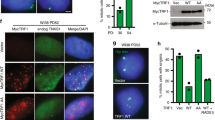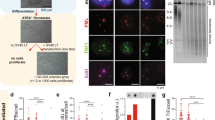Abstract
Telomeres protect chromosome ends from fusion and degradation1. In the absence of a specific telomere elongation mechanism, their DNA shortens progressively with every round of replication, leading to replicative senescence2. Here, we show that telomerase-deficient cells bearing a single, very short telomere senesce earlier, demonstrating that the length of the shortest telomere is a major determinant of the onset of senescence. We further show that Mec1p–ATR specifically recognizes the single, very short telomere causing the accelerated senescence. Strikingly, before entering senescence, cells divide for several generations despite complete erosion of their shortened telomeres. This pre-senescence growth requires RAD52 (radiation sensitive) and MMS1 (methyl methane sulfonate sensitive), and there is no evidence for major inter-telomeric recombination. We propose that, in the absence of telomerase, a very short telomere is first maintained in a pre-signalling state by a RAD52–MMS1-dependent pathway and then switches to a signalling state leading to senescence through a Mec1p-dependent checkpoint.
This is a preview of subscription content, access via your institution
Access options
Subscribe to this journal
Receive 12 print issues and online access
$209.00 per year
only $17.42 per issue
Buy this article
- Purchase on Springer Link
- Instant access to full article PDF
Prices may be subject to local taxes which are calculated during checkout





Similar content being viewed by others
Change history
24 March 2010
In the version of this letter initially published online, the labels '0 block' and '2 block' in Fig. 2a were swapped. This error has been corrected in both the HTML and PDF versions of the article.
References
Palm, W. & de Lange, T. How shelterin protects mammalian telomeres. Ann. Rev. Gen. 42, 301–334 (2008).
Gilson, E. & Geli, V. How telomeres are replicated. Nature Rev. Mol. Cell Biol. 8, 825–838 (2007).
Hemann, M. T., Strong, M. A., Hao, L. Y. & Greider, C. W. The shortest telomere, not average telomere length, is critical for cell viability and chromosome stability. Cell 107, 67–77 (2001).
Marcand, S., Brevet, V. & Gilson, E. Progressive cis-inhibition of telomerase upon telomere elongation. Embo J. 18, 3509–3519 (1999).
Sabourin, M., Tuzon, C. T. & Zakian, V. A. Telomerase and Tel1p preferentially associate with short telomeres in S. cerevisiae. Mol. Cell 27, 550–561 (2007).
Decourty, L. et al. Linking functionally related genes by sensitive and quantitative characterization of genetic interaction profiles. Proc. Natl Acad. Sci. USA 105, 5821–5826 (2008).
Lundblad, V. & Blackburn, E. H. An alternative pathway for yeast telomere maintenance rescues est1- senescence. Cell 73, 347–360 (1993).
Enomoto, S., Glowczewski, L. & Berman, J. MEC3, MEC1, and DDC2 are essential components of a telomere checkpoint pathway required for cell cycle arrest during senescence in Saccharomyces cerevisiae. Mol. Biol. Cell. 13, 2626–2638 (2002).
Forstemann, K., Hoss, M. & Lingner, J. Telomerase-dependent repeat divergence at the 3′ ends of yeast telomeres. Nucleic Acids Res. 28, 2690–2694 (2000).
Louis, E. J. The chromosome ends of Saccharomyces cerevisiae. Yeast 11, 1553–1573 (1995).
Sandell, L. L. & Zakian, V. A. Loss of a yeast telomere: arrest, recovery, and chromosome loss. Cell 75, 729–739 (1993).
Leroy, C. et al. PP2C phosphatases Ptc2 and Ptc3 are required for DNA checkpoint inactivation after a double-strand break. Mol. Cell 11, 827–835 (2003).
Teixeira, M. T., Arneric, M., Sperisen, P. & Lingner, J. Telomere length homeostasis is achieved via a switch between telomerase- extendible and -nonextendible states. Cell 117, 323–335 (2004).
Teng, S. C. & Zakian, V. A. Telomere-telomere recombination is an efficient bypass pathway for telomere maintenance in Saccharomyces cerevisiae. Mol. Cell. Biol. 19, 8083–8093 (1999).
Krogh, B. O. & Symington, L. S. Recombination proteins in yeast. Ann. Rev. Gen. 38, 233–271 (2004).
Duro, E., Vaisica, J. A., Brown, G. W. & Rouse, J. Budding yeast Mms22 and Mms1 regulate homologous recombination induced by replisome blockage. DNA Repair (Amst) 7, 811–818 (2008).
Hryciw, T., Tang, M., Fontanie, T. & Xiao, W. MMS1 protects against replication-dependent DNA damage in Saccharomyces cerevisiae. Mol. Genet. Genomics 266, 848–857 (2002).
Ui, A. et al. Activation of a novel pathway involving Mms1 and Rad59 in sgs1 cells. Biochem. Biophys. Res. Commun. 356, 1031–1037 (2007).
Zaidi, I. W. et al. Rtt101 and Mms1 in budding yeast form a CUL4(DDB1)-like ubiquitin ligase that promotes replication through damaged DNA. EMBO Rep. 9, 1034–1040 (2008).
Zhao, X., Muller, E. G. & Rothstein, R. A suppressor of two essential checkpoint genes identifies a novel protein that negatively affects dNTP pools. Mol. Cell 2, 329–340 (1998).
Ijpma, A. S. & Greider, C. W. Short Telomeres Induce a DNA Damage Response in Saccharomyces cerevisiae. Mol. Biol. Cell 14, 987–1001 (2003).
Bianchi, A. & Shore, D. Increased association of telomerase with short telomeres in yeast. Genes Dev. 21, 1726–1730 (2007).
Arneric, M. & Lingner, J. Tel1 kinase and subtelomere-bound Tbf1 mediate preferential elongation of short telomeres by telomerase in yeast. EMBO Rep. 8, 1080–1085. (2007).
Hector, R. E. et al. Tel1p preferentially associates with short telomeres to stimulate their elongation. Mol. Cell 27, 851–858 (2007).
Ritchie, K. B., Mallory, J. C. & Petes, T. D. Interactions of TLC1 (which encodes the RNA subunit of telomerase), TEL1, and MEC1 in regulating telomere length in the yeast Saccharomyces cerevisiae. Mol. Cell. Biol. 19, 6065–6075 (1999).
Mantiero, D., Clerici, M., Lucchini, G. & Longhese, M. P. Dual role for Saccharomyces cerevisiae Tel1 in the checkpoint response to double-strand breaks. EMBO Rep. 8, 380–387 (2007).
Sadaie, M., Naito, T. & Ishikawa, F. Stable inheritance of telomere chromatin structure and function in the absence of telomeric repeats. Genes Dev. 17, 2271–2282 (2003).
Khadaroo, B. et al. The DNA damage response at eroded telomeres and tethering to the nuclear pore complex. Nature Cell Biol., doi: 10.1038/ncb1910 (this issue).
Schaetzlein, S. et al. Exonuclease-1 deletion impairs DNA damage signaling and prolongs lifespan of telomere-dysfunctional mice. Cell 130, 863–877 (2007).
Jeyapalan, J. C., Ferreira, M., Sedivy, J. M. & Herbig, U. Accumulation of senescent cells in mitotic tissue of aging primates. Mech. Ageing Dev. 128, 36–44 (2007).
Marcand, S., Gilson, E. & Shore, D. A protein-counting mechanism for telomere length regulation in yeast. Science 275, 986–990 (1997). .
Mallory, J. C. & Petes, T. D. Protein kinase activity of Tel1p and Mec1p, two Saccharomyces cerevisiae proteins related to the human ATM protein kinase. Proc. Natl Acad. Sci. USA 97, 13749–13754 (2000).
Longhese, M. P., Paciotti, V., Neecke, H. & Lucchini, G. Checkpoint proteins influence telomeric silencing and length maintenance in budding yeast. Genetics 155, 1577–1591 (2000).
Abramoff, M. D., Magelhaes, P. J. & Ram, S. J. Image Processing with ImageJ. Biophotonics Int. 11, 36–42 (2004).
Ihaka, R. & Gentleman, R. R. : a language for data analysis and graphics. J. Comp. Graph. Stat. 5, 299–314 (1996).
Tresaugues, L. et al. Structural characterization of Set1 RNA recognition motifs and their role in histone H3 lysine 4 methylation. J. Mol. Biol. 359, 1170–1181 (2006).
Acknowledgements
We thank R. Wellinger and L. Rudolph for fruitful suggestions, G. Yvert and C. Lopes for advice in statistical analysis and A. Jacquier for sharing unpublished material. We also thank T. Petes, M. P. Longhese and S. Marcand for strains and plasmids. P.A. gratefully acknowledges the financial support of the Lebanese National council for Scientific Research (CNRSL) and the Association pour la Recherche sur le Cancer (ARC). This work was supported by La Ligue Contre le Cancer (E.G. and V.G., équipes labellisées), the INCa programmes TELINCA and TELOFUN (E.G. and V.G.), The Danish Agency for Science, Technology and Innovation (M.L.), the Villum Kann Rasmussen Foundation (M.L.) and the National Institutes of Health (K.R.).
Author information
Authors and Affiliations
Contributions
P.A., P.L. and M.T.T. carried out and analysed the experiments. E.G. and M.T.T. designed and directed the project with the contribution of K.W.R., M.L. and V.G.
Corresponding author
Ethics declarations
Competing interests
The authors declare no competing financial interests.
Supplementary information
Supplementary Information
Supplementary Information (PDF 835 kb)
Rights and permissions
About this article
Cite this article
Abdallah, P., Luciano, P., Runge, K. et al. A two-step model for senescence triggered by a single critically short telomere. Nat Cell Biol 11, 988–993 (2009). https://doi.org/10.1038/ncb1911
Received:
Accepted:
Published:
Issue Date:
DOI: https://doi.org/10.1038/ncb1911
This article is cited by
-
Non-canonical telomere protection role of FOXO3a of human skeletal muscle cells regulated by the TRF2-redox axis
Communications Biology (2023)
-
Progeroide Syndrome
Die Dermatologie (2023)
-
Telomere DNA length regulation is influenced by seasonal temperature differences in short-lived but not in long-lived reef-building corals
Nature Communications (2023)
-
Telomere shortening causes distinct cell division regimes during replicative senescence in Saccharomyces cerevisiae
Cell & Bioscience (2021)
-
The central role of DNA damage in the ageing process
Nature (2021)



